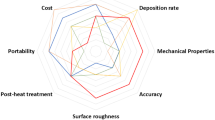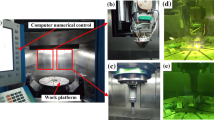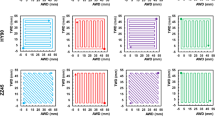Abstract
Directed energy deposition (DED) is capable of manufacturing high-density and complex metal components, whereas traditional machining methods are limited in these regards. Nevertheless, the fabrication of parts with DED that have accurate dimensions and geometries as well as acceptable surface states is a concern, as these factors are inferior to those of traditionally machined components. Therefore, the application of parts fabricated with DED is restricted. Thus, the hybrid additive/subtractive manufacturing (HASM) method has been exploited to comprehensively utilize the advantages of both. In this paper, the HASM method was used to fabricate bulk parts with four different scanning strategies (alternating the orientation of subsequent layers by 0°, 45°, and 90° and island scanning are referred to as an X-scan, a Rot-scan, an XY-scan, and an Island-scan, respectively) followed by subtractive milling to gain a smooth surface with a determined thickness for the next scanning and deposition period until the parts were completely finished. The influence of the scanning strategy on the densification level and mechanical behavior of the specimens fabricated with HASM was studied. The results show that the specimens fabricated with the 7 × 7 mm2 island scan with short scan vector lengths showed a higher densification than the specimens fabricated using long scan vector lengths (the three methods mentioned above). Finally, to obtain a fine surface finish, the influence of the feed per tooth (fz) on the surface quality of a 316L stainless steel during the milling process that occurs during the HASM process was also investigated. The result shows a fz of 0.25 mm yielding the minimum surface roughness value among the samples observed herein, which implies that the surface quality was better than that of the other studied conditions.










Similar content being viewed by others
References
Gray GT, Livescu V, Rigg PA, Trujillo CP, Cady CM, Chen SR, Carpenter JS, Lienert TJ, Fensin SJ (2017) Structure/property (constitutive and spallation response) of additively manufactured 316L stainless steel. Acta Mater 138:140–149
Harrison NJ, Todd I, Mumtaz K (2015) Reduction of micro-cracking in nickel superalloys processed by selective laser melting: a fundamental alloy design approach. Acta Mater 94:59–68
Gu DD, Meiners W, Wissenbach K, Poprawe R (2012) Laser additive manufacturing of metallic components: materials, processes and mechanisms. Int Mater Rev 57(3):133–164
Contaldi V, Del Re F, Palumbo B, Squillace A, Corrado P, Di Petta P (2019) Mechanical characterisation of stainless steel parts produced by direct metal laser sintering with virgin and reused powder. Int J Adv Manuf Technol 105(7–8):3337–3351
Akbari M, Kovacevic R (2019) Closed loop control of melt pool width in robotized laser powder-directed energy deposition process. Int J Adv Manuf Technol 104(5–8):2887–2898
Jhang SS, Lo YL, Le TN (2019) Systematic modeling approach for analyzing the powder flow and powder energy absorptivity in direct energy deposition system. Int J Adv Manuf Technol. https://doi.org/10.1007/s00170-019-04441-3
Wang ZQ, Palmer TA, Beese AM (2016) Effect of processing parameters on microstructure and tensile properties of austenitic stainless steel 304L made by directed energy deposition additive manufacturing. Acta Mater 110:226–235
AlMangour B, Yang JM (2017) Understanding the deformation behavior of 17–4 precipitate hardenable stainless steel produced by direct metal laser sintering using micropillar compression and TEM. Int J Adv Manuf Technol 90(1–4):119–126
Ning JQ, Sievers DE, Garmestani H, Liang SY (2019) Analytical modeling of transient temperature in powder feed metal additive manufacturing during heating and cooling stages. Applied Physics A 125:496
Ning JQ, Liang SY (2018) Model-driven determination of Johnson-Cook material constants using temperature and force measurements. Int J Adv Manuf Technol 97(1–4):1053–1060
Zhou YG, Ma LJ, Gong YD, Zhang L, Yin GQ, Sun Y (2019) Study on the mechanism of chip forming and the microhardness of micro-grinding nickel-based single-crystal superalloy. Int J Adv Manuf Technol 103(1–4):281–295
Pace ML, Guarnaccio A, Dolce P, Mollica D, Parisi GP, Lettino A, Medici L, Summa V, Ciancio R, Santagata A (2017) 3D additive manufactured 316L components microstructural features and changes induced by working life cycles. Appl Surf Sci 418:437–445
Yadollahi A, Shamsaei N, Thompson SM, Seely DW (2015) Effects of process time interval and heat treatment on the mechanical and microstructural properties of direct laser deposited 316L stainless steel. Mat Sci Eng A 644:171–183
Yang YY, Gong YD, Qu SS, Rong YL, Sun Y, Cai M (2018) Densification, surface morphology, microstructure and mechanical properties of 316L fabricated by hybrid manufacturing. Int J Adv Manuf Technol 97(5–8):2687–2696
Le VT, Paris H, Mandil G (2017) Environmental impact assessment of an innovative strategy based on an additive and subtractive manufacturing combination. J Clean Prod 164:508–523
Ye ZP, Zhang ZJ, Jin X, Xiao MZ, Su JZ (2017) Study of hybrid additive manufacturing based on pulse laser wire depositing and milling. Int J Adv Manuf Technol 88(5–8):2237–2248
Zhao YH, Sun J, Li JF, Wang PF, Zheng ZC, Chen JW, Yan YQ (2018) The stress coupling mechanism of laser additive and milling subtractive for FeCr alloy made by additive-subtractive composite manufacturing. J Alloy Compd 769:898–905
Wei P, Wei ZY, Chen Z, Du J, He YY, Li JF, Zhou YT (2017) The AlSi10Mg samples produced by selective laser melting: single track, densification, microstructure and mechanical behavior. Appl Surf Sci 408:38–50
Qiu CL, Adkins NJE, Attallah MM (2016) Selective laser melting of Invar 36: microstructure and properties. Acta Mater 103:382–395
AlMangour B, Grzesiak D, Yang JM (2017) Scanning strategies for texture and anisotropy tailoring during selective laser melting of TiC/316L stainless steel nanocomposites. J Alloy Compd 728:424–435
Xiong XH, Zhang HO, Wang GL (2009) Metal direct prototyping by using hybrid plasma deposition and milling. J Mater Process Tech 209(1):124–130
Zhu HH, Fuh JYH, Lu L (2007) The influence of powder apparent density on the density in direct laser-sintered metallic parts. Int J Mach Tool Manu 47(2):294–298
Xiong W, Hao L, Li Y, Tang DN, Cui Q, Feng ZY, Yan CZ (2019) Effect of selective laser melting parameters on morphology, microstructure, densification and mechanical properties of supersaturated silver alloy. Mater Design 170:10769711
Qu SS, Gong YD, Yang YY, Sun Y, Wen XL, Qi Y (2020) Investigating Minimum Quantity Lubrication in Unidirectional Cf/SiC composite grinding. Ceram Int 46:3582–3591
Qu SS, Gong YD, Yang YY et al (2019) Grinding characteristics and removal mechanisms of unidirectional carbon fibre reinforced silicon carbide ceramic matrix composites. Ceram Int 45:3059–3071
Gong YD, Qu SS, Yang YY, Liang CY, Li PF, She YB (2019) Some observations in grinding SiC and silicon carbide ceramic matrix composite material. Int J Adv Manuf Technol
Woo W, Kim DK, Kingston EJ, Luzin V, Salvemini F, Hill MR (2019) Effect of interlayers and scanning strategies on through-thickness residual stress distributions in additive manufactured ferritic-austenitic steel structure. Mat Sci Eng A 744:618–629
Nadammal N, Cabeza S, Mishurova T, Thiede T, Kromm A, Seyfert C, Farahbod L, Haberland C, Schneider JA, Portella PD (2017) Effect of hatch length on the development of microstructure, texture and residual stresses in selective laser melted superalloy Inconel 718. Mater Design 134:139–150
Sun SH, Hagihara K, Nakano T (2018) Effect of scanning strategy on texture formation in Ni-25 at.%Mo alloys fabricated by selective laser melting. Mater Design 140:307–316
Funding
The author wishes to thank the National Natural Science Foundation of China (No. 51775100) and the Fundamental Research Funds for the Central Universities of China (No. N180306001 and N170313025) for financial assistance.
Author information
Authors and Affiliations
Corresponding author
Additional information
Publisher’s note
Springer Nature remains neutral with regard to jurisdictional claims in published maps and institutional affiliations.
Rights and permissions
About this article
Cite this article
Yang, Y., Gong, Y., Qu, S. et al. Densification, mechanical behaviors, and machining characteristics of 316L stainless steel in hybrid additive/subtractive manufacturing. Int J Adv Manuf Technol 107, 177–189 (2020). https://doi.org/10.1007/s00170-020-05033-2
Received:
Accepted:
Published:
Issue Date:
DOI: https://doi.org/10.1007/s00170-020-05033-2




